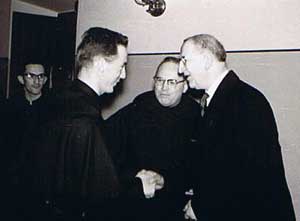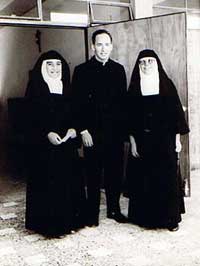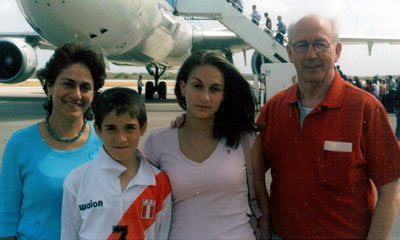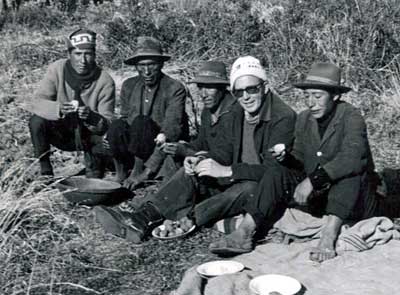|
Life
changes
Then my
life changed greatly. For a long time I had questioned the
whole concept of celibacy in the priesthood. It all came to a
head for me in 1981 when I decided to opt out of the ministry.
With a heavy heart I left the South Andes and settled in Lima
where I commenced work with a Peruvian NGO called Servicios
Educativos Rurales (Rural Educational Services), an NGO
dedicated to the rural population of Peru, the campesinos,
the very kind of people I had ministered to previously. Now I
would be working with them on a national level, obviously in a
different role. This NGO had various areas of work; I began
work in the Communications Area where we edited a magazine
called 'Andenes' in order to help the campesinos
at a national level to be informed on the political, agrarian,
social/economic and the cultural and ecclesiastical realities
of Peru. I was responsible for a section of the magazine we
called Nuestras Costumbres (Our Customs). In that section over
the years we published the campesinos' own accounts of
their customs, their fiestas, their agrarian rituals,
their poetry, their stories and their legends. We also held
annual competitions to invite them to paint and draw the
reality in which they were living.
|

With Eamon de Valera and Fr. Killian Healy in
the Carmelite Theologate, Rome 1961 |
I remember
1992, the year Spain celebrated what they called the 500th
anniversary of the 'discovery' of South America. I think later
they changed the wording of 'discovery' to 'el encuentro de
dos culturas' (the meeting of two cultures) because of
protests from South America against the use of the term
'discovery'. Not that a 'meeting of two cultures' pleased
South Americans either, for they saw it more as an invasion or
even as a genocide. On that occasion we invited the
campesinos of Peru to paint or draw what they felt about
the arrival of the Spaniards to their country and the
consequences for themselves. I could safely say that it was
the first time that native Peruvians had been asked to express
their opinions on a topic that had such devastating
consequences for them over the centuries. And express it they
did, portraying graphically the many forms in which the
indigenous population have suffered exploitation and
injustices to this very day.
Governments come and go
In the
thirty years that I lived in Peru, I saw several governments
come and go. When I arrived in Peru in 1964, Fernando Belaúnde
Terry was the democratically elected president. Four years
later I was back in Ireland on my first holiday back home when
one morning after breakfast a fellow Carmelite asked me, 'Des,
did you hear, your president had been deported from Peru?' In
the early hours of 3 October 1968, a bloodless military coup
led by General Juan Velasco Alvarado surrounded the
presidential palace. Belaúnde was taken out in his pyjamas and
later that day sent on a plane to Buenos Aires. So began
twelve years of military dictatorship.
The armed
forces have always played a decisive role in Peru's political
history. Since 1930 there have been four periods of military
rule lasting a total of thirty years. For most of this century
the military's political interventions were in support of the
right, but during the Velasco government (1968-1975) a new
current of reformist nationalism became dominant within the
armed forces. The Velasco government implemented a radical
programme which marked the first decisive break with the
economic model imposed by the Spanish conquest. This involved
ending the political domination and economic power of the
oligarchy; the modernisation of the Peruvian state and a major
expansion of its role in the economy; the search for a more
equitable relationship with foreign capital; and major changes
in land and property ownership.
Twelve
years later, Belaúnde made a comeback when a more moderate
General Morales Bermudez moved towards restoring democracy and
allowed new elections, permitting Belaúnde to return again to
popular acclaim. Belaúnde thus commenced his second term as
president in July 1980 in a Peru that differed in fundamental
ways from the Peru that he had left abruptly in 1968. The
final years of his presidency were marked by the rise of
Sendero Luminoso (Shining Path) in 1980.
|

With Carmelite nuns at the
Cieneguilla language institute, 1964 |
The return
to constitutional rule was accompanied by the restoration of
formal democratic freedoms but this in itself could not create
a democratic society. The government showed no inclination to
reform powerful institutions which were suffused with
undemocratic practices and a traditional bias towards the rich
and powerful. Current affairs programmes on television that
were critical of the government had a checkered career,
several being removed from the screen by the television
companies themselves. During this period the radical
subversive group Sendero Luminoso, whose
ideological roots lay in a fundamentalist version of Maoism,
developed their guerrilla war.
By 1984
real income per capita had fallen back to the level of twenty
years before. While all but the small elite became poorer,
impoverishment was concentrated in the sierra and coastal
shanty towns. This has been a constant reality in Peruvian
history. Sendero Luminoso believed that the
conditions for revolution existed and that the road to
communism in Peru lay through 'a prolonged popular war'.
Another subversive but less radical group called the Tupac
Amaru Movement also initiated their military campaign in this
period. The government's initial response to Sendero
and to the Tupac Amaru Movement was to minimise the guerrilla
threat, but their counter-insurgency policy soon hardened as a
state of emergency was declared in five provinces, later to be
extended to many more, and the infamous island prison El
Frontón was reopened to hold Sendero suspects.
Sendero extended their campaign over a much wider area,
including the capital Lima. They destroyed pylons causing
regular blackouts in the entire city.
We were
living in Lima at that time. It was the first time I
experienced collective fear in the city in the midst of
blackouts, car bombs and selective assassinations. As popular
unrest and social upheaval increased, so did government
repression. Eventually Belaúnde handed over total
responsibility for counter-insurgency to the armed forces
chiefs-of-staff. This internal war was to continue until 2000,
throughout the governments of Fernando Belaúnde (1980-1985),
Alan Garcia (1985-1990) and Alberto Fujimori (1990-2000). More
than 69,000 people died or disappeared at the hands of
guerrilla groups, paramilitaries and the armed forces during
that internal war.
|

The author with his family
in
Bon Aire enroute to Peru, July 2006 |
A
family man
In the
midst of all these changes and upheavals my own life continued
to change. In 1990 I married a human rights lawyer called
Patricia Abozaglo from Lima. We met at my workplace. Our two
children Fiona and Patrick were born in Lima, Fiona in 1992
and Patrick in 1994. My work contract was coming to an end in
1995, so we decided to return to Ireland. Initially I was to
study for a year in post-graduate development studies in
Kimmage Manor, Dublin and at the same time to look around for
job options. Fortunately my wife got a job with Tróocaire right
away and I got a teaching job in a secondary school in Dublin
teaching Spanish, Irish and Religion. We had been in Dublin
for four years when we went searching for a house which
brought us to our present home in Maynooth, County Kildare,
just a forty- minute drive from my birthplace, Kilbeggan,
County Westmeath. So indeed I have come full circle. I am back
here, from where I set out for Peru some forty years ago.
Somewhat wiser I do believe. I am still teaching Spanish which
I enjoy greatly. I love introducing people to a new language
and opening up to them a whole new world of discovery.
Latin American connections
Since we
came back from Peru we have always kept in contact with
Peruvians and other Latin Americans who live in Ireland - and
there are quite a few. Over the years we have got together for
many parties, and now each July we have quite a gathering in
Dublin in Terenure College to celebrate Peru's national
holiday on 28 July. I suppose it is something like the
Westmeath/Longford Association that celebrates their
connection with Argentina every year.
Many years
ago I visited Argentina and spent a few days in Buenos Aires.
I stayed at the Passionist priests' house. I remember at meal
time hearing them switch back and forth in their conversation
between Spanish and English. There was an elderly priest
beside me and when he talked to me in English I could clearly
hear his Westmeath accent. He told me that his father - or was
it his grandfather - was from Moyvore in Westmeath. Another
memory I have with an Argentinean connection is meeting an
Argentinean priest in Cuzco years ago. He told me that his
parish was in the south of Argentina and that most of his
parishioners were of Irish descent. He told me how good they
were to him. He invited me to go and visit him and I must say
it is one of the regrets I have that I never did get to visit
him and meet all those Irish Argentineans and hear their
stories. So now you have my story, or at least a good part of
it.
Desmond
Kelleher |





